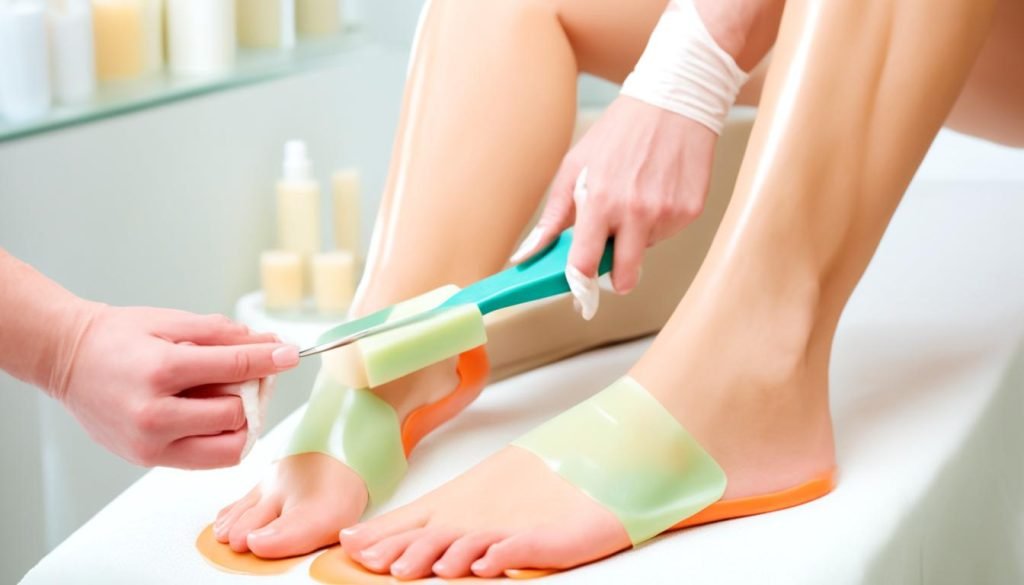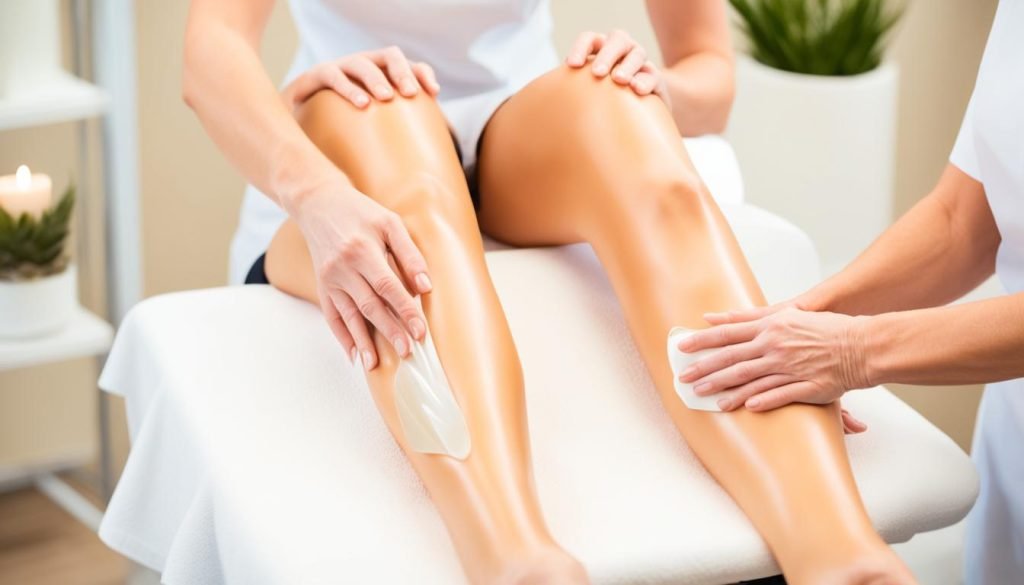Ever thought if getting smooth legs is worth the pain of waxing? Leg waxing is a popular way to remove hair, promising smooth skin for weeks. But, it raises questions about the pain involved. This article will cover what to expect during waxing, from the wax types to tips for easing discomfort. Knowing how to prepare and care for your skin before and after can make a big difference.
Key Takeaways
- Leg waxing can offer lasting smoothness but may involve discomfort.
- Understanding the waxing process can help alleviate anxiety about pain.
- Preparation techniques can significantly reduce leg waxing pain.
- Aftercare is essential for minimizing waxing discomfort.
- Different types of wax affect pain levels differently.
Introduction to Leg Waxing
Leg waxing is a popular way to get smooth, hair-free skin. It gives immediate results and has many long-term benefits. Many people choose it for effective leg hair removal because of these advantages.
Benefits of Hair Removal
Waxing your legs can make your skin look and feel better. The main benefits are:
- Long-lasting smoothness for up to six weeks
- Less chance of ingrown hairs than shaving
- Potential weakening of hair follicles, leading to finer hair growth
Comparative Hair Removal Methods
Choosing the right method for removing leg hair is key. Each method has its own pros and cons:
| Method | Advantages | Disadvantages |
|---|---|---|
| Waxing | Long-lasting results, less chance of bumps | Painful for some, requires expertise |
| Shaving | Quick and inexpensive | Frequent maintenance needed, prone to cuts |
| Depilatory Creams | Easy application | Possible skin reactions, limited duration |
| Laser Hair Removal | Potential for permanent results | Higher cost, multiple sessions required |
When waxing sensitive areas, think about the pros and cons of each method. This will help you find the best one for your skin and preferences.
How Does Leg Waxing Work?
The leg waxing process removes hair from the follicle for a longer-lasting result than shaving. The type of wax used affects how well and comfortably the waxing works. Experts often pick between soft wax and hard wax depending on the area and how sensitive it is.
The Types of Wax Used
Each wax type has its own benefits in leg waxing. Here's a look at soft wax versus hard wax:
| Feature | Soft Wax | Hard Wax |
|---|---|---|
| Application Method | Applied thinly with a spatula | Applied thickly without strips |
| Removal Method | Requires cloth strips for removal | Removed by pulling the wax directly |
| Ideal for | Larger areas, such as legs | Sensitive areas, like the bikini line |
| Pain Level | Higher due to removal with strips | Lower as it adheres only to the hair |
| Skin Type | Best for normal to thick skin | Better for sensitive skin types |
Choosing the right wax is key for a smooth leg waxing experience. Understanding the differences between soft and hard wax helps in making the right choice for your waxing needs.

Does Leg Wax Hurt?
Many people wonder, “Does leg wax hurt?” The answer varies a lot. Knowing about waxing discomfort factors helps set the right expectations. It prepares you for what's to come.
Factors Affecting Pain Levels
Several things affect how much it hurts during leg waxing:
- Skin Sensitivity: If your skin is more sensitive, you might feel more pain.
- Hair Thickness: Thicker hair is harder to remove and hurts more.
- Technique Used: Different ways of waxing can make it more or less painful.
- Area of Waxing: Some parts of the body are more sensitive than others.
Most people find that waxing gets less painful over time. As hair grows back finer, and skin gets less sensitive, the experience gets better.
| Factor | Impact on Pain Levels |
|---|---|
| Skin Sensitivity | Higher sensitivity may increase pain |
| Hair Thickness | Thicker hair leads to more discomfort |
| Technique Used | Technique compatibility affects sensation |
| Area of Waxing | More nerve endings equate to more pain |
Managing and Reducing Waxing Pain
Learning how to handle waxing pain can make the experience much better. By using certain pre-wax tips and proper post-wax care, you can lessen the discomfort. Getting ready before the waxing and taking good care after is key to easing the pain.
Pre-Wax Preparation Tips
There are important steps to take to lessen waxing pain. Here are some pre-wax tips to consider:
- Ensure hair length is approximately ¼ inch to facilitate smoother removal.
- Avoid using irritating skincare products 24-48 hours prior to waxing.
- Refrain from consuming caffeine and alcohol, as these substances can increase skin sensitivity.
- Exfoliate the skin gently a day before to remove dead skin cells and prepare the area.
Post-Wax Care to Alleviate Pain
It's vital to take good care of your skin after waxing to reduce pain and discomfort. Here are some post-wax care tips:
- Apply hydrocortisone cream to alleviate redness and inflammation.
- Use ice packs on the waxed area to soothe any swelling or irritation.
- Avoid hot showers immediately after waxing to prevent aggravation of the skin.
- Maintain a gentle exfoliation routine a few days post-wax to prevent ingrown hairs.

| Tips | Purpose |
|---|---|
| Right Hair Length | Optimizes hair removal |
| Avoid Irritants | Reduces skin sensitivity |
| Limit Caffeine/Alcohol | Helps in managing waxing pain |
| Hydrocortisone Cream | Reduces redness and swelling |
| Ice Packs | Soothes inflammation |
Conclusion
The waxing experience can be different for everyone, especially when wondering, does leg wax hurt? By understanding the process and preparing well, you can lessen the pain. Most people find that smooth skin for a long time is worth the initial discomfort.
Choosing how to remove leg hair means balancing your pain tolerance with the pros and cons of each option. Many find that waxing gets easier with time, making it a good choice for those looking for a reliable way to remove hair.
FAQ
Does leg waxing hurt?
Yes, leg waxing can be painful. It involves pulling hair from the root. But, the pain level varies from person to person.
What factors affect leg waxing pain?
Skin sensitivity, hair thickness, and waxing technique play a role in pain. The bikini line is more sensitive and hurts more than the thighs.
How can I manage the pain of leg waxing?
To lessen the pain, make sure your hair is about ¼ inch long. Avoid harsh skincare products before waxing. Taking pain relievers before can also help.
Using cold compresses and following aftercare tips can ease the pain after waxing.
What should I do for post-wax care?
After waxing, use hydrocortisone cream to lessen redness. Ice packs can soothe inflammation. Avoid hot showers and gently exfoliate to prevent ingrown hairs.
Is waxing better than shaving for leg hair removal?
Waxing lasts longer, up to six weeks, and is less likely to cause bumps. But, it requires less maintenance than shaving. Your choice should depend on what you prefer and how much pain you can handle.
What types of wax are used for leg waxing?
Two main types of wax are used: hard wax and soft wax. Hard wax sticks to hair and is pulled out without strips. Soft wax comes with strips and is removed quickly.
Source Links
- How Painful Is Waxing? We Asked Dermatologists How to Reduce the Burn – https://www.byrdie.com/does-waxing-hurt-1717231
- Leg Waxing: Does it Last, Does it Hurt, Here’s What You Should Know – https://www.bodydetails.com/blog/leg-waxing-does-it-last-does-it-hurt-heres-what-you-should-know/
- Why Leg Waxing Will Change Your Life – Waxxpot Waxing Salon – https://waxxpot.com/blog/leg-waxing/
Recent Posts
It's important to evaluate whether Beachbody On Demand continues to meet your fitness needs as we enter 2025. With a range of workout programs and nutrition plans, the platform claims to cater to...
Just like having a personal trainer at your fingertips, Beachbody On Demand offers you an extensive library of on-demand workout programs accessible anytime, anywhere. This service allows you to...

